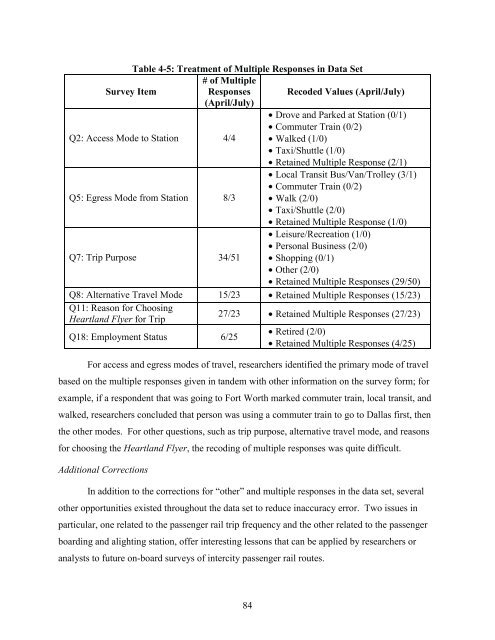Measuring the Benefits of Intercity Passenger Rail: A Study
Measuring the Benefits of Intercity Passenger Rail: A Study
Measuring the Benefits of Intercity Passenger Rail: A Study
You also want an ePaper? Increase the reach of your titles
YUMPU automatically turns print PDFs into web optimized ePapers that Google loves.
Survey Item<br />
Table 4-5: Treatment <strong>of</strong> Multiple Responses in Data Set<br />
# <strong>of</strong> Multiple<br />
Responses<br />
(April/July)<br />
Q2: Access Mode to Station 4/4<br />
Q5: Egress Mode from Station 8/3<br />
84<br />
Recoded Values (April/July)<br />
• Drove and Parked at Station (0/1)<br />
• Commuter Train (0/2)<br />
• Walked (1/0)<br />
• Taxi/Shuttle (1/0)<br />
• Retained Multiple Response (2/1)<br />
• Local Transit Bus/Van/Trolley (3/1)<br />
• Commuter Train (0/2)<br />
• Walk (2/0)<br />
• Taxi/Shuttle (2/0)<br />
• Retained Multiple Response (1/0)<br />
Q7: Trip Purpose 34/51<br />
• Leisure/Recreation (1/0)<br />
• Personal Business (2/0)<br />
• Shopping (0/1)<br />
• O<strong>the</strong>r (2/0)<br />
• Retained Multiple Responses (29/50)<br />
Q8: Alternative Travel Mode 15/23 • Retained Multiple Responses (15/23)<br />
Q11: Reason for Choosing<br />
Heartland Flyer for Trip<br />
27/23 • Retained Multiple Responses (27/23)<br />
Q18: Employment Status 6/25<br />
• Retired (2/0)<br />
• Retained Multiple Responses (4/25)<br />
For access and egress modes <strong>of</strong> travel, researchers identified <strong>the</strong> primary mode <strong>of</strong> travel<br />
based on <strong>the</strong> multiple responses given in tandem with o<strong>the</strong>r information on <strong>the</strong> survey form; for<br />
example, if a respondent that was going to Fort Worth marked commuter train, local transit, and<br />
walked, researchers concluded that person was using a commuter train to go to Dallas first, <strong>the</strong>n<br />
<strong>the</strong> o<strong>the</strong>r modes. For o<strong>the</strong>r questions, such as trip purpose, alternative travel mode, and reasons<br />
for choosing <strong>the</strong> Heartland Flyer, <strong>the</strong> recoding <strong>of</strong> multiple responses was quite difficult.<br />
Additional Corrections<br />
In addition to <strong>the</strong> corrections for “o<strong>the</strong>r” and multiple responses in <strong>the</strong> data set, several<br />
o<strong>the</strong>r opportunities existed throughout <strong>the</strong> data set to reduce inaccuracy error. Two issues in<br />
particular, one related to <strong>the</strong> passenger rail trip frequency and <strong>the</strong> o<strong>the</strong>r related to <strong>the</strong> passenger<br />
boarding and alighting station, <strong>of</strong>fer interesting lessons that can be applied by researchers or<br />
analysts to future on-board surveys <strong>of</strong> intercity passenger rail routes.
















